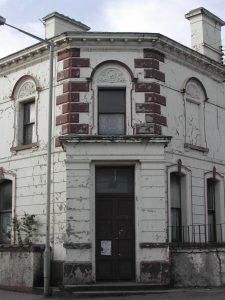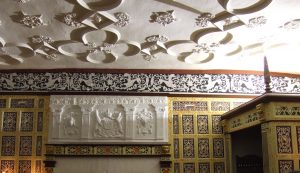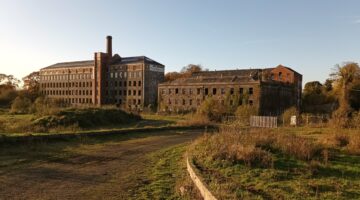 Paint has long been used for the decoration and protection of timber, metal and plaster coatings, and the correct specification is a complex task. Painted surfaces on old buildings will have been built up in many layers and careful stripping back of a small sample area will give clues to a building’s decorative history. There are specialists who can sample and analyse layers of historic paint and give advise on reproduction. Caution must be taken when rubbing down old paintwork to avoid inhalation of toxic dust, particularly on timber, because of the former use of lead-based paints. Currently the use of lead paint is restricted by stringent Health and Safety regulations.
Paint has long been used for the decoration and protection of timber, metal and plaster coatings, and the correct specification is a complex task. Painted surfaces on old buildings will have been built up in many layers and careful stripping back of a small sample area will give clues to a building’s decorative history. There are specialists who can sample and analyse layers of historic paint and give advise on reproduction. Caution must be taken when rubbing down old paintwork to avoid inhalation of toxic dust, particularly on timber, because of the former use of lead-based paints. Currently the use of lead paint is restricted by stringent Health and Safety regulations.
Putting together a new, historically correct painting scheme is a specialist task for a major building, but for a building owner wishing to redecorate, the same principles apply.
- Walls should also be allowed to continue to breathe. If water does penetrate a wall, sealing with ‘waterproof’ paints will only temporarily mask the problem or make it appear elsewhere. Breathable paints for both internal and external use are available.
- The quality of a finished scheme relies on thorough preparation of the surfaces – rubbing down, cleaning, stopping and priming. The top coat will not hide deficiencies in the preparation.
- Choosing the appropriate paint system for the particular material is vital, including the choice of primers.
 Internal paint work varies from simple colour washes to highly decorative tromp l’oeil. Several commercial companies are now offering a comprehensive range of ‘historically accurate’ paint colours, but for a very intricate and valuable interior, scientific analysis may be necessary in order to reproduce a colour exactly.
Internal paint work varies from simple colour washes to highly decorative tromp l’oeil. Several commercial companies are now offering a comprehensive range of ‘historically accurate’ paint colours, but for a very intricate and valuable interior, scientific analysis may be necessary in order to reproduce a colour exactly.
Internal timber surfaces in public buildings may need to be treated to reduce the surface spread of flame. This is achieved by applying approved intumescent paints or stains. The work must be carried out in accordance with the manufacturer’s instructions in order to guarantee the system meets the required protection level. The work should also be carried out in relatively warm conditions to avoid clouding the varnish.
Also in this section:
- How to look after your historic building?
- 1) Masonry – Stone & Brick
- 2) Roofing – Slating, Tiling & Thatch
- 3) Roofing – Leadwork & Copper
- 4) Ironmongery & Metalwork
- 5) Joinery
- 6) Plasterwork and Renders
- 7) Glass and Glazing
- 8) Tiles and Tiling
- 9) Paintwork
- 10) Fittings
- 11) Remedial Works
- 12) Services
- 13) Specialist Surveys & Photography
- 14) Funding
- Guide to Abbreviations Used

